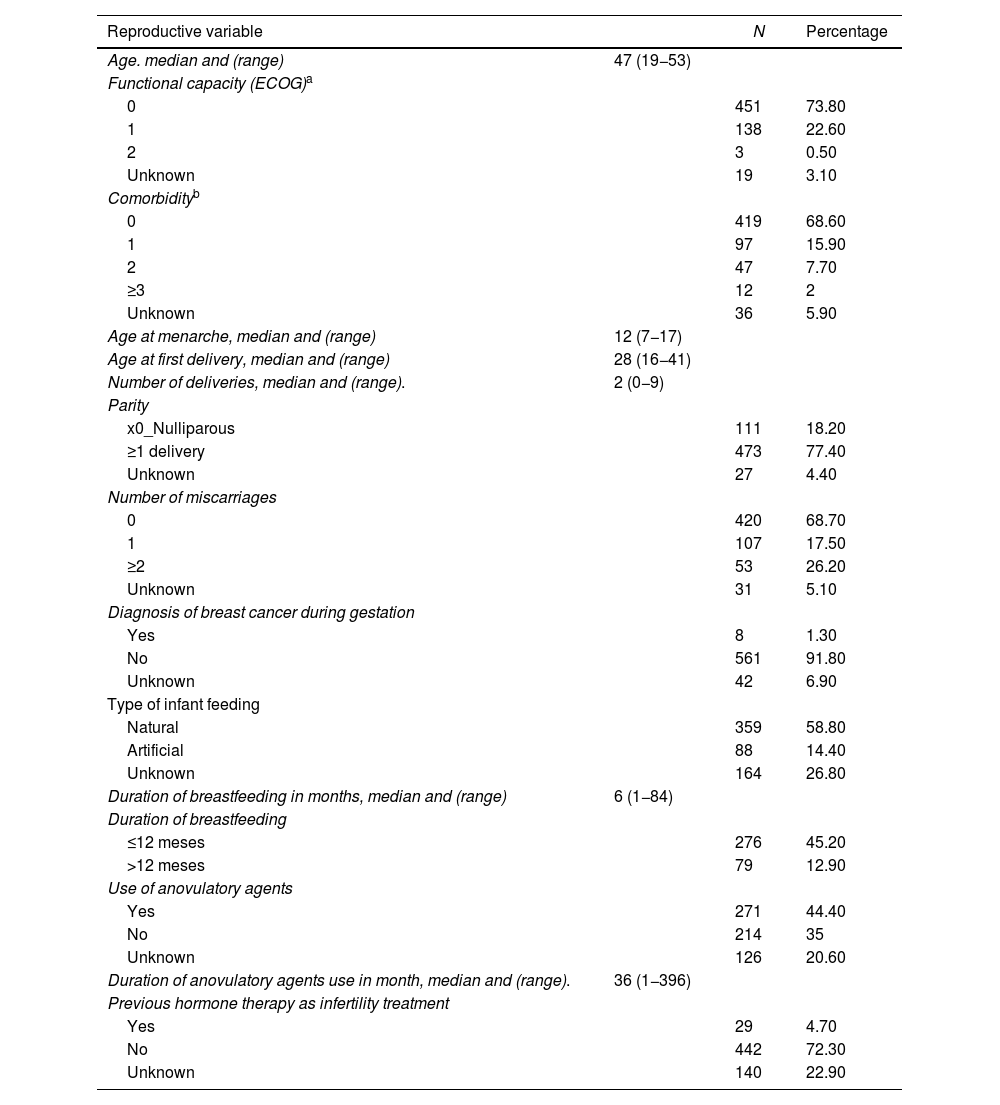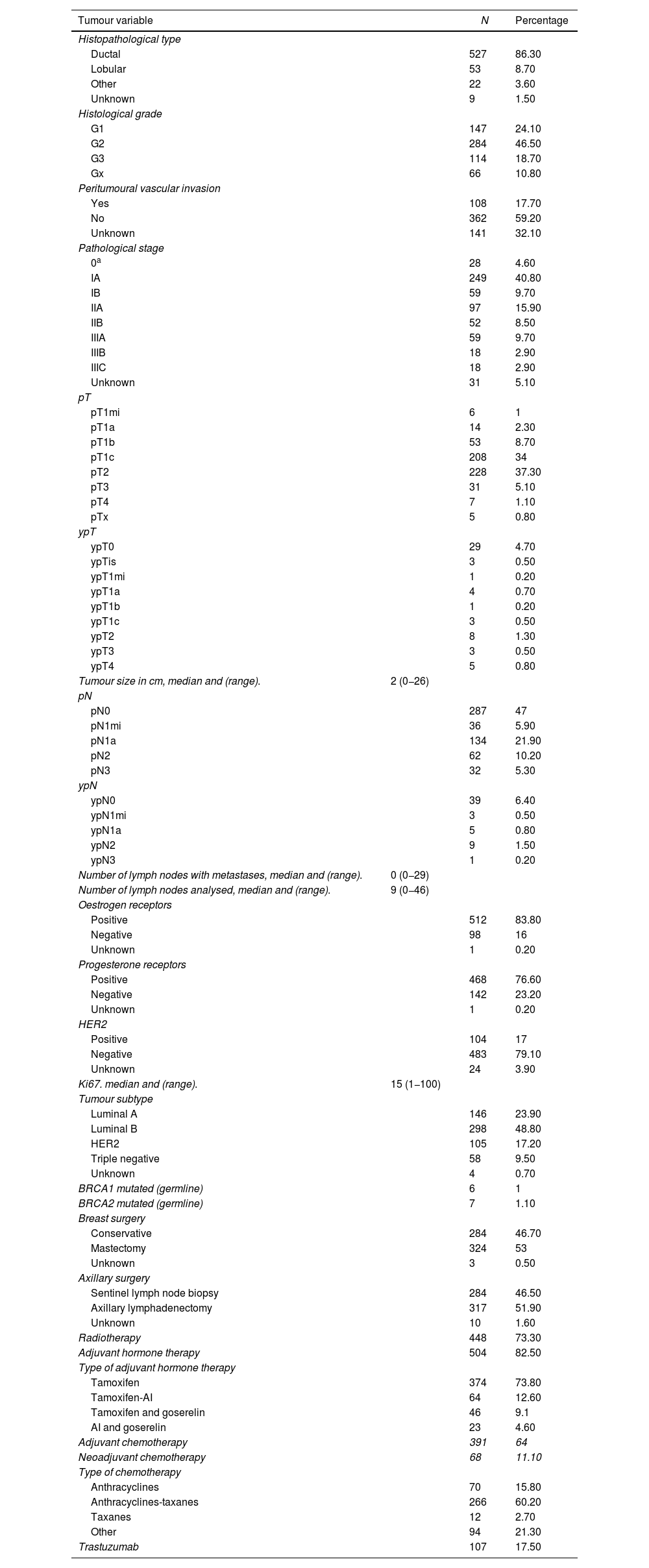Reproductive history influences breast cancer risk. We analysed its association with tumour subtype and survival in premenopausal women.
Patients and methodsRetrospective, observational study of premenopausal women with stage I–III breast carcinoma in the last 20 years. Review of reproductive history, clinical data, and treatments in health records.
ResultsIn 661 premenopausal women (32.40% of 1377 total cases), median age was 47 years (19−53), menarche 12 (7−17), first delivery 28 (16−41) and number of deliveries 2 (0−9). One hundred and eleven (18.20%) were nulliparous. Three hundred and fifty-nine (58.80%) used natural lactation, with a median duration of 6 months. Anovulatory drugs were used by 271 (44.40%), with a median duration of 36 months.
Associations were found between menarche <10 years and lower risk of luminal subtype (OR 0.52, 95%CI 0.28−0.94; p = 0.03), between menarche >11 years and lower risk of HER2 subtype (OR 0.50, 95%CI 0.26−0.97; p = 0.04) and between first birth >30 years and lower risk of triple negative subtype (OR 0.40, 95%CI 0.17−0.93; p = 0.03).
The 20-year overall and disease-free survival probabilities were 0.80 (95% CI 0.71−0.90) and 0.72 (95% CI 0.64−0.79) respectively. Patients with ≥1 delivery had better overall survival than nulliparous patients (HR 0.51, 95% CI 0.27−0.96, p = 0.04).
ConclusionsThe findings suggest an association between age at menarche and age at first delivery and breast cancer subtype. Nulliparity is associated with worse survival.
La historia reproductiva influye en el riesgo de cáncer de mama. Hemos analizado su asociación con el subtipo tumoral y la supervivencia en mujeres premenopáusicas.
Pacientes y métodosEstudio observacional, retrospectivo, de mujeres premenopáusicas con carcinoma de mama, estadios I-III, en los últimos 20 años. Revisión de la historia reproductiva, datos clínicos y tratamientos en las historias de salud.
ResultadosEn 661 mujeres premenopáusicas (32,40% de 1377 totales), la mediana de edad fue 47 años (19−53), de la menarquia 12 (7−17), del primer parto 28 (16−41) y de número de partos 2 (0−9). Fueron nulíparas 111 (18.20%). Emplearon lactancia natural 359 (58,80%) con mediana de duración de 6 meses. Consumieron anovulatorios 271 (44,40%), con mediana de 36 meses.
Se halló asociación entre menarquia <10 años y menos riesgo de subtipo luminal (OR 0,52, IC95% 0,28−0,94; p = 0,03), entre menarquia >11 años y menos riesgo de subtipo HER2 (OR 0,50, IC95% 0,26−0,97; p = 0,04) y entre primer parto >30 años y menos riesgo de subtipo triple negativo (OR 0,40, IC95% 0,17−0,93; p = 0,03).
La probabilidad de supervivencia global y libre de enfermedad a 20 años fue 0,80 (IC 95% 0,71−0,90) y 0,72 (IC 95% 0,64−0,79) respectivamente. Las pacientes con ≥1 parto presentaron mejor supervivencia global que las nulíparas (HR 0,51, IC 95% 0,27−0,96, p = 0,04).
ConclusionesLos hallazgos sugieren que existe asociación entre edad de la menarquia y del primer parto y subtipo de cáncer de mama. La nuliparidad está asociada con peor supervivencia.
Artículo
Comprando el artículo el PDF del mismo podrá ser descargado
Precio 19,34 €
Comprar ahora












